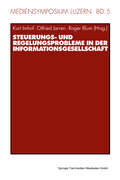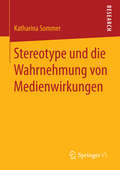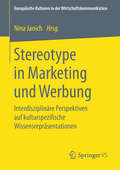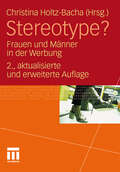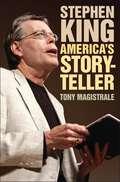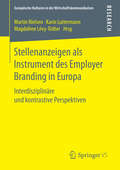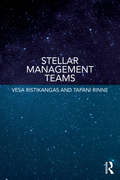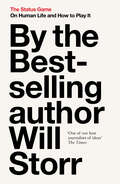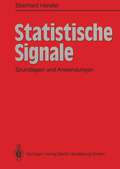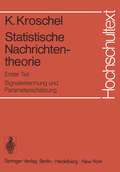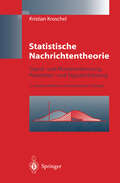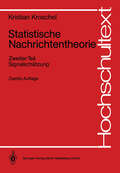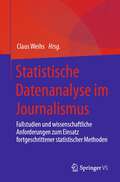- Table View
- List View
Steuerungs- und Regelungsprobleme in der Informationsgesellschaft (Mediensymposium #5)
by Kurt Imhof Otfried Jarren Roger Blumit Bezug auf die bemerkenswerten Veränderungen der öffentlichen politischen Kommunikation seit den sechziger Jahren, insbesondere jedoch seit der Deregulierung der elektronischen Medien und der ökonomischen Konzentration, Globalisierung und Diversifizierung des Mediensystems in den achtziger Jahren, gilt das Interesse des Bandes den Steuerungs- und Regelungsproblemen in der Informationsgesellschaft. Dies erfordert eine gesamtgesellschaftliche Perspektive, die das Verhältnnis der Systeme Politik, Ökonomie und Medien fokussiert. Der gewandelte Zusammenhang der drei Teilsysteme lässt sich beschreiben als Resultat zweier gegenläufiger Entwicklungen: der Ausdifferenzierung des Mediensystems vom politischen System einerseits sowie der Entdifferenzierung der Medien vom ökonomischen System andererseits.
Stereotype und die Wahrnehmung von Medienwirkungen
by Katharina SommerKatharina Sommer fragt danach, wie die Aktivierung von Stereotypen die Einschätzung von Medienwirkungen auf Dritte beeinflussen kann: Stereotypisierung findet meist unbewusst statt und ist in sozialen Situationen ein alltäglich ablaufender Prozess. Die Autorin verbindet die Frage nach den Einflussfaktoren auf die Wahrnehmung von Medienwirkungen mit dem Prozess der Stereotypisierung zu unterschiedlichen Personengruppen. Auf diese Weise verdeutlicht sie, dass die Einschätzung von Medienwirkung situativ unterschiedlich ausfallen kann, je nachdem, welche Stereotype gerade aktiviert wurden.
Stereotype in Marketing und Werbung
by Nina JanichDer Band vereinigt Beiträge verschiedenster Disziplinen zu Stereotypen in Werbung und Marketing. Schwerpunkte liegen auf Risiken und Potenzialen von Stereotypen in der Markt- und Personalkommunikation, auf ihrer Bedeutung im Nation/Place Branding sowie auf sozialen Stereotypisierungen in unterschiedlichen Kontexten (u.a. in Markenkommunikation, B2B, HRM). Der Begriff des Stereotyps hat sich – so das Ergebnis – fachübergreifend in Sprach-, Kommunikations-, Medien-, Werbe- und Wirtschaftswissenschaft als ein Konzept bewährt, das Einsichten über kultur-, zeit- und branchenspezifische Orientierungs- und Identifikationsangebote in der Unternehmenskommunikation verspricht.
Stereotype?: Frauen und Männer in der Werbung
by Christina Holtz-BachaFrauen sind jung, schön und schlank. Männer sind harte Jungs, die Tölpel in der Küche oder sehen einfach nur gut aus. Die Klage darüber, dass die Werbung Frauen und Männer auf solche Stereotypen reduziert, ist ebenso alt wie die Befürchtungen, dass diese Stereotypen gesellschaftliche Auswirkungen haben. Gelten sie heute noch? Dieses Buch zieht Bilanz nach rund 50 Jahren Forschung zu Werbung und Geschlechterstereotypen und legt neue Ergebnisse aus der Analyse von Werbung vor sowie darüber, wie Rezipientinnen und Rezipienten mit solcher Werbung umgehen.
Stereotype?: Frauen und Männer in der Werbung
by Christina Holtz-BachaFrauen sind jung, schön und schlank. Männer sind harte Jungs, die Tölpel in der Küche oder sehen einfach nur gut aus. Die Klage darüber, dass die Werbung Frauen und Männer auf solche Stereotypen reduziert, ist ebenso alt wie die Befürchtungen, dass diese Stereotypen gesellschaftliche Auswirkungen haben. Gelten sie heute noch? Dieses Buch zieht Bilanz nach rund 50 Jahren Forschung zu Werbung und Geschlechterstereotypen und legt neue Ergebnisse aus der Analyse von Werbung vor sowie darüber, wie Rezipientinnen und Rezipienten mit solcher Werbung umgehen.
Stereoanalyse und Bildsynthese
by O. SchreerIn diesem Buch werden die mathematischen Grundlagen der 3D-Bildanalyse dargestellt. Dazu gehören die Modellierung von Kameras, die geometrischen Beziehungen zwischen zwei und mehreren Kameraansichten sowie eine Übersicht über Standardverfahren der Stereoanalyse. Ebenfalls führt der Autor in die mathematischen Grundlagen der Bildsynthese ein und gibt einen Überblick über existierende Verfahren. Das Buch überzeugt durch seine geschlossene Darstellung der mathematischen Grundlagen von Bildanalyse und -synthese in einheitlicher Form und Notation. Es wendet sich an Studierende der Elektrotechnik, der Kommunikationstechnik und Informatik sowie an Praktiker, die sich einen raschen Zugang zum Thema verschaffen wollen.
Stephen King: America's Storyteller (Non-ser.)
by Tony MagistraleThis analysis of the work of Stephen King explores the distinctly American fears and foibles that King has celebrated, condemned, and generally examined in the course of his wildly successful career.Stephen King: America's Storyteller explores the particular American-ness of Stephen King's work. It is the first major examination to follow this defining theme through King's 40-year career, from his earliest writings to his most recent novels and films made from them.Stephen King begins by tracing Stephen King's rise from his formative years to his status as a one of the most popular writers in publishing history. It then takes a close look at the major works from his canon, including The Shining, The Stand, It, Dolores Claiborne, and The Dark Tower. In these works and others, author Tony Magistrale focuses on King's deep rooted sense of the American experience, exemplified by his clear-eyed presentation of our historical and cultural foibles and scars; his gallery of unlikely friendships that cross race, age, and class boundaries; and his transcendent portrayals of uniquely American survival instincts, fellowship, and acts of heroism from the least likely of sources.
Stellenanzeigen als Instrument des Employer Branding in Europa: Interdisziplinäre und kontrastive Perspektiven (Europäische Kulturen in der Wirtschaftskommunikation #23)
by Martin Nielsen Magdalène Lévy-Tödter Karin LuttermannDer Band versammelt Studien zum Thema Stellenanzeige aus sprach-, kultur-, marketingwissenschaftlicher und juristischer Perspektive, die eine differenzierte Herangehensweise an diese Textsorte im Rahmen des Human Resource Management ermöglichen. Untersucht werden im interdisziplinären Zusammenspiel Funktionen und Wirkungsmittel von Stellenanzeigen im europäischen Kontext des Employer Branding. Die Beiträge zeigen, dass Unternehmen im verschärften Wettbewerb um hochqualifizierte Mitarbeiter viele Möglichkeiten haben, sich als attraktiver Arbeitgeber zu positionieren.
Stellar Management Teams
by Vesa Ristikangas Tapani RinneManagement teams at all levels, and individual team members in particular, are often disengaged and disconnected from the management function itself. Statements such as, "we lack common goals or they are unclear", "I have no influence", "I am not listened to nor taken into account", and "I do not feel valued – actually, nobody does", are commonplace. The authors argue this is because we have been entrenched in an era of guru leadership but that it must come to an end if our management teams are to rise to the top. An individual is not capable of controlling the complicated system of an organization, with its countless variables, especially in conjunction with the rapid change in both the economy and market forces, which are unpredictable and uncontrollable. No matter how talented the individual, no one person is in a position to manage this complex system alone – not even a guru leader. The authors contend that what is needed now are resilient trendsetters who will bring about a new era of top-performing teams that together form a "collective guru", which they refer to as a Stellar Management Team. In this book, the reader undertakes a metaphorical journey to the stars, which symbolizes top-level interaction and collaboration. The journey is the development from an ordinary management team into a Stellar Management Team, which elevates its operation up to a new level of performance and success.
Stellar Management Teams
by Vesa Ristikangas Tapani RinneManagement teams at all levels, and individual team members in particular, are often disengaged and disconnected from the management function itself. Statements such as, "we lack common goals or they are unclear", "I have no influence", "I am not listened to nor taken into account", and "I do not feel valued – actually, nobody does", are commonplace. The authors argue this is because we have been entrenched in an era of guru leadership but that it must come to an end if our management teams are to rise to the top. An individual is not capable of controlling the complicated system of an organization, with its countless variables, especially in conjunction with the rapid change in both the economy and market forces, which are unpredictable and uncontrollable. No matter how talented the individual, no one person is in a position to manage this complex system alone – not even a guru leader. The authors contend that what is needed now are resilient trendsetters who will bring about a new era of top-performing teams that together form a "collective guru", which they refer to as a Stellar Management Team. In this book, the reader undertakes a metaphorical journey to the stars, which symbolizes top-level interaction and collaboration. The journey is the development from an ordinary management team into a Stellar Management Team, which elevates its operation up to a new level of performance and success.
Steganography Techniques for Digital Images
by Abid YahyaThis book covers newly developed and novel Steganography techniques and algorithms. The book outlines techniques to provide security to a variety of applications using Steganography, with the goal of both hindering an adversary from decoding a hidden message, and also preventing an adversary from suspecting the existence of covert communications. The book looks into applying these newly designed and improved algorithms to provide a new and efficient Steganographic system, called Characteristic Region-Based Image Steganography (CR-BIS). The algorithms combine both the robustness of the Speeded-Up Robust Features technique (SURF) and Discrete Wavelet Transform (DWT) to achieve characteristic region Steganography synchronization. The book also touches on how to avoid hiding data in the whole image by dynamically selecting characteristic regions for the process of embedding. Applies and discusses innovative techniques for hiding text in a digital image file or even using it as a key to the encryption;Provides a variety of methods to achieve characteristic region Steganography synchronization;Shows how Steganography improves upon cryptography by using obscurity features.
Steam-Powered Knowledge: William Chambers and the Business of Publishing, 1820-1860
by Aileen FyfeWith the overwhelming amount of new information that bombards us each day, it is perhaps difficult to imagine a time when the widespread availability of the printed word was a novelty. In early nineteenth-century Britain, print was not novel—Gutenberg’s printing press had been around for nearly four centuries—but printed matter was still a rare and relatively expensive luxury. All this changed, however, as publishers began employing new technologies to astounding effect, mass-producing instructive and educational books and magazines and revolutionizing how knowledge was disseminated to the general public. In Steam-Powered Knowledge, Aileen Fyfe explores the activities of William Chambers and the W. & R. Chambers publishing firm during its formative years, documenting for the first time how new technologies were integrated into existing business systems. Chambers was one of the first publishers to abandon traditional skills associated with hand printing, instead favoring the latest innovations in printing processes and machinery: machine-made paper, stereotyping, and, especially, printing machines driven by steam power. The mid-nineteenth century also witnessed dramatic advances in transportation, and Chambers used proliferating railway networks and steamship routes to speed up communication and distribution. As a result, his high-tech publishing firm became an exemplar of commercial success by 1850 and outlived all of its rivals in the business of cheap instructive print. Fyfe follows Chambers’s journey from small-time bookseller and self-trained hand-press printer to wealthy and successful publisher of popular educational books on both sides of the Atlantic, demonstrating along the way the profound effects of his and his fellow publishers’ willingness, or unwillingness, to incorporate these technological innovations into their businesses.
Steam-Powered Knowledge: William Chambers and the Business of Publishing, 1820-1860
by Aileen FyfeWith the overwhelming amount of new information that bombards us each day, it is perhaps difficult to imagine a time when the widespread availability of the printed word was a novelty. In early nineteenth-century Britain, print was not novel—Gutenberg’s printing press had been around for nearly four centuries—but printed matter was still a rare and relatively expensive luxury. All this changed, however, as publishers began employing new technologies to astounding effect, mass-producing instructive and educational books and magazines and revolutionizing how knowledge was disseminated to the general public. In Steam-Powered Knowledge, Aileen Fyfe explores the activities of William Chambers and the W. & R. Chambers publishing firm during its formative years, documenting for the first time how new technologies were integrated into existing business systems. Chambers was one of the first publishers to abandon traditional skills associated with hand printing, instead favoring the latest innovations in printing processes and machinery: machine-made paper, stereotyping, and, especially, printing machines driven by steam power. The mid-nineteenth century also witnessed dramatic advances in transportation, and Chambers used proliferating railway networks and steamship routes to speed up communication and distribution. As a result, his high-tech publishing firm became an exemplar of commercial success by 1850 and outlived all of its rivals in the business of cheap instructive print. Fyfe follows Chambers’s journey from small-time bookseller and self-trained hand-press printer to wealthy and successful publisher of popular educational books on both sides of the Atlantic, demonstrating along the way the profound effects of his and his fellow publishers’ willingness, or unwillingness, to incorporate these technological innovations into their businesses.
Steam-Powered Knowledge: William Chambers and the Business of Publishing, 1820-1860
by Aileen FyfeWith the overwhelming amount of new information that bombards us each day, it is perhaps difficult to imagine a time when the widespread availability of the printed word was a novelty. In early nineteenth-century Britain, print was not novel—Gutenberg’s printing press had been around for nearly four centuries—but printed matter was still a rare and relatively expensive luxury. All this changed, however, as publishers began employing new technologies to astounding effect, mass-producing instructive and educational books and magazines and revolutionizing how knowledge was disseminated to the general public. In Steam-Powered Knowledge, Aileen Fyfe explores the activities of William Chambers and the W. & R. Chambers publishing firm during its formative years, documenting for the first time how new technologies were integrated into existing business systems. Chambers was one of the first publishers to abandon traditional skills associated with hand printing, instead favoring the latest innovations in printing processes and machinery: machine-made paper, stereotyping, and, especially, printing machines driven by steam power. The mid-nineteenth century also witnessed dramatic advances in transportation, and Chambers used proliferating railway networks and steamship routes to speed up communication and distribution. As a result, his high-tech publishing firm became an exemplar of commercial success by 1850 and outlived all of its rivals in the business of cheap instructive print. Fyfe follows Chambers’s journey from small-time bookseller and self-trained hand-press printer to wealthy and successful publisher of popular educational books on both sides of the Atlantic, demonstrating along the way the profound effects of his and his fellow publishers’ willingness, or unwillingness, to incorporate these technological innovations into their businesses.
Steam-Powered Knowledge: William Chambers and the Business of Publishing, 1820-1860
by Aileen FyfeWith the overwhelming amount of new information that bombards us each day, it is perhaps difficult to imagine a time when the widespread availability of the printed word was a novelty. In early nineteenth-century Britain, print was not novel—Gutenberg’s printing press had been around for nearly four centuries—but printed matter was still a rare and relatively expensive luxury. All this changed, however, as publishers began employing new technologies to astounding effect, mass-producing instructive and educational books and magazines and revolutionizing how knowledge was disseminated to the general public. In Steam-Powered Knowledge, Aileen Fyfe explores the activities of William Chambers and the W. & R. Chambers publishing firm during its formative years, documenting for the first time how new technologies were integrated into existing business systems. Chambers was one of the first publishers to abandon traditional skills associated with hand printing, instead favoring the latest innovations in printing processes and machinery: machine-made paper, stereotyping, and, especially, printing machines driven by steam power. The mid-nineteenth century also witnessed dramatic advances in transportation, and Chambers used proliferating railway networks and steamship routes to speed up communication and distribution. As a result, his high-tech publishing firm became an exemplar of commercial success by 1850 and outlived all of its rivals in the business of cheap instructive print. Fyfe follows Chambers’s journey from small-time bookseller and self-trained hand-press printer to wealthy and successful publisher of popular educational books on both sides of the Atlantic, demonstrating along the way the profound effects of his and his fellow publishers’ willingness, or unwillingness, to incorporate these technological innovations into their businesses.
Stay Tuned: A History of American Broadcasting (Routledge Communication Series)
by Christopher H. Sterling John Michael KittrossSince its initial publication in 1978, Stay Tuned has been recognized as the most comprehensive and useful single-volume history of American broadcasting and electronic media available. This third edition has been thoroughly revised and updated to bring the story of American broadcasting forward to the 21st century, affording readers not only the history of the most important and pervasive institution affecting our society, but also providing a contextual transition to the Internet and other modern media. The enthusiasm of authors Christopher H. Sterling and John Michael Kittross is apparent as they lead readers through the development of American electronic mass media, from the first electrical communication (telegraph and telephone); through radio and television; to the present convergence of media, business entities, programming, and delivery systems, including the Internet. Their presentation is engaging, as well as informative, promoting an interest in history and making the connections between the developments of yesterday and the industry of today. Features of this third edition include: *chronological and topical tables of contents; *new material reflecting modern research in the field; *a new chapter describing historical developments from 1988 through to the current day; *an expanded bibliography, including Web site and museum listings; *an updated and expanded glossary and chronology; and *extensive statistical data of the development of television and radio stations, networks, advertising, programming, audiences, and other aspects of broadcasting. Designed for use in undergraduate and graduate courses on the history of American mass media, broadcasting, and electronic media, Stay Tuned also fits well into mass communication survey courses as an introduction to electronic media topics. As a chronicle of American broadcasting, this volume is also engaging reading for anyone interested in old radio, early television, and the origins and development of American broadcasting.
The Status Game: On Social Position And How We Use It
by Will StorrFrom the Sunday Times bestselling author of The Science of Storytelling, a bold and ambitious investigation of the hidden structure behind human behaviour: status
Statistische Signale: Grundlagen und Anwendungen
by Eberhard HänslerDer Praktiker erhält einen ausreichenden Hintergrund für den experimentellen Umgang mit Signalen.Die einzelnen Abschnitte beginnen mit einer kurzen Herleitung oder Definition und schließen mit durchgerechneten Beispielen.
Statistische Signale: Grundlagen und Anwendungen
by Eberhard HänslerDieses Lehrbuch behandelt statistische Signalmodelle aus der Sicht der Systemtheorie. Es entstand aus Vorlesungen des Autors an der TH Darmstadt für Studenten der Nachrichten- und Regelungstechnik nach dem Vorexamen. Im Gegensatz zur klassischen Theorie werden in diesem Buch Signale durch Zufallsprozesse modelliert. Nach einem kurzen Abriß der wichtigsten Gesetze der Wahrscheinlichkeitsrechnung werden Zufallsvariable und Zufallsprozesse behandelt. Hieran schließt sich die Betrachtung der Zusammenhänge zwischen den Eigenschaften des Eingangs- und des Ausgangsprozesses eines Systems an. Breiten Raum nehmen dabei Korrelationsfunktionen und Leistungsdichtespektren ein. Im zweiten Teil des Buches werden Anwendungen statistischer Sig- nalmodelle dargestellt. Im Vordergrund steht dabei die Optimierung linearer Systeme. Im einzelnen werden diskutiert: Signalangepaßtes Filter, Prädiktor, Optimalfilter nach Wiener und Kolmogoroff, Kalman-Filter und adaptive Filter. Die einzelnen Abschnitte des Buches beginnen in der Regel mit einer kurzen Herleitung oder einer Definition. Anschließend werden die neu eingeführten Größen diskutiert und Verbindungen zu bereits bekannten Zusammenhängen hergestellt. Jeder Abschnitt schließt mit durchgerechneten Beispielen. Die Darstellung des Stoffes bewegt sich auf dem Mittelweg zwischen "rein anschaulich" und "streng formal". Das Buch gibt daher einem Praktiker einen ausreichenden Hintergrund für den experimentellen Umgang mit Signalen. Gleichzeitig bereitet es Theoretiker auf das Studium weiterführender Darstellungen vor.
Statistische Nachrichtentheorie: Erster Teil: Signalerkennung und Parameterschätzung (Hochschultext)
by Kristian KroschelStatistische Nachrichtentheorie: Signal- und Mustererkennung, Parameter- und Signalschätzung
by Kristian KroschelStatistische Nachrichtentheorie: Erster Teil Signalerkennung und Parameterschätzung (Hochschultext)
by Kristian KroschelStatistische Informationstechnik: Signal - und Mustererkennung, Parameter- und Signalschätzung
by Kroschel Kristian Gerhard Rigoll Björn W. SchullerDie Autoren behandeln die Signalerkennung im Rauschen, die Mustererkennung sowie die Parameter- und Signalschätzung. Grundlegende Fragen veranschaulichen sie anhand von Anwendungsbeispielen. Berücksichtigt werden moderne Verfahren wie Wavelet-Transformation und neben klassischen Detektionsverfahren auch neuere, beispielsweise Klassifikatoren, die auf neuronale Netze und Fuzzy-Logik aufbauen. Die 5. Auflage wurde im Bereich des maschinellen Lernens substanziell erweitert. Der Band ist geeignet für Studierende wie für Ingenieure in der Praxis.
Statistische Datenanalyse im Journalismus: Fallstudien und wissenschaftliche Anforderungen zum Einsatz fortgeschrittener statistischer Methoden
Dieses Buch zeigt anhand von journalistischen Fallbeispielen, warum und wie fortgeschrittene statistische Analysemethoden eingesetzt werden können, um aussagekräftige journalistische Informationen aus Daten zu extrahieren. Gleichzeitig setzt das Buch einen Anforderungsrahmen für die datenjournalistische Arbeit bezüglich Datenkompetenz und -visualisierung, dem Einsatz von Algorithmen sowie daten-ethischen Anforderungen und der Überprüfung externer Studien. Ziel ist es, die Qualität und Aussagekraft datenjournalistischer Arbeiten zu verbessern, welche, neben der angemessenen Erfassung und Aufbereitung von Daten, wesentlich von einer adäquaten Datenanalyse abhängen. Aber wie statistisch arbeiten Datenjournalist:innen heute eigentlich? Und wie statistisch können oder sollten sie arbeiten, um den Ansprüchen ihrer Leserschaft in Sachen Verständlichkeit gerecht zu werden, auch mit Blick auf deren unterschiedliches mathematisch-statisches Vorwissen? Das Buch zielt darauf ab, diese Fragen zu beantworten, indem es weiterführende statistische Methoden anhand von Fallstudien untersucht. Es verdeutlicht, warum diese Methoden auch im journalistischen Kontext oftmals problemangemessener sind und tiefer gehende Erkenntnisse liefern als vereinfachte Analysen und Basismethoden. Die Fallstudien decken dabei die wichtigsten statistischen Methoden ab: Verteilungen und Tests, Klassifikation, Regression, Zeitreihenanalyse, Clusteranalyse, Analyse von sequentiellen Daten ohne direkten Zeitbezug, Verwendung von Vorwissen und geplante Studien.
